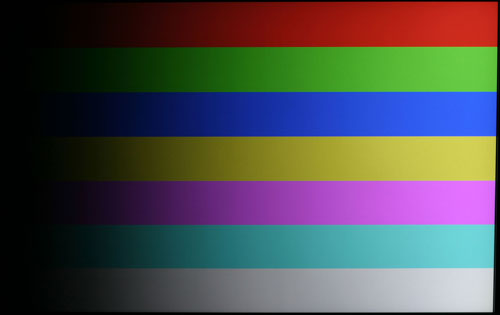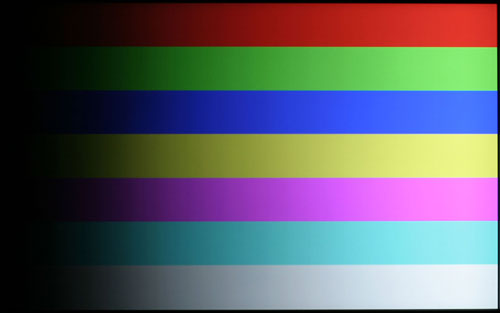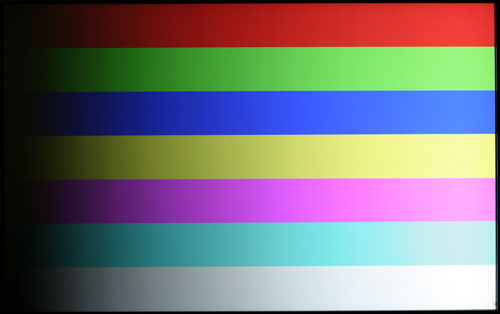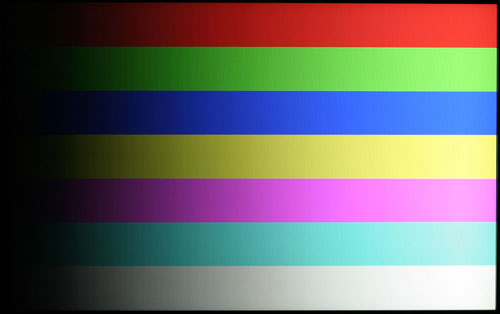Dell 2407WFP and 3007WFP LCD Comparison
by Jarred Walton on March 2, 2007 11:30 AM EST- Posted in
- Displays
Subjective Evaluation
Given that most users do not have access to hardware display calibration tools, we spent some time using the displays without ever properly calibrating them in order to gain an impression of how most users would react. We will start with our subjective evaluation before getting to the actual quantitative results.
Having used several LCDs including a Dell 2405FPW, the newer Dell models definitely look a little better in side-by-side comparisons. If you can't do a side-by-side comparison, though, it is much less likely that you would notice the difference. The newer displays look a little brighter and have slightly better colors and viewing angles, but we could be happy using pretty much any current 24" LCD. Outside of the lack of inputs and the massive size of the 3007WFP, subjectively there really wasn't a huge difference between the various LCDs.
One area that continues to be somewhat irritating on the 24" Dell LCDs is the default resolutions you get in Windows. Naturally 1920x1200 is present, and that will be the desired resolution if at all possible, but most other 16:10 aspect ratio resolutions don't show up and you need to use a utility to add support for 1680x1050 and 1440x900. If you lack the graphics hardware to run some games at native resolution, being able to drop the resolution down one notch while still maintaining a widescreen aspect ratio is convenient. The 30" Dell LCD does much better in the resolution department, with basically every resolution you would expect to find showing up without the need for any utilities/tweaks. We mentioned in the Gateway FPD2485W review that it appeared to have difficulty scaling 1680x1050 to fit its native resolution, while other resolutions scaled better. Both of the Dell LCDs seem to do better overall on scaling, although you still get the typical slightly blurred look when running at non-native resolutions.
The Gateway FPD2485W still holds the record as the brightest large LCD that we've used, but it's almost to the point of being too bright. We haven't felt the need to run any of the LCDs at maximum brightness, but in the case of the Gateway dropping it down to as little as 30% brightness at times was reasonable. So far, we have yet to experience an LCD that doesn't have a moderate amount of backlight bleed, and the brighter the display is the worst backlight bleed tends to be. After using the FPD2485W for a couple weeks, both Dell LCDs are a bit better at producing dark blacks, and unlike the Gateway LCD we didn't notice any issues with uniformity of color/lighting.
We took a closer look at the ability to reproduce a smooth color gradient on all of the displays we've tested so far. The Dell 3007WFP ranks at the top of the chart in terms of producing a smooth gradient, followed closely by the 2407WFP. Meanwhile, the Gateway FPD2485W and the older Dell 2405FPW show some banding issues when viewing gradients, particularly in the darker colors. People who do a lot of image editing are more likely to notice the problems in reproducing smooth gradients, and we actually weren't bothered by any of the monitors, but other users may be more demanding.
Trying to provide a good representation of what the gradients looked like is quite difficult, as you can't take a normal screenshot and using a camera to photograph the display is rather like making a copy of a copy. After a bit of trial and error, we were able to get images that at least convey something of the issues that we noticed with banding. You'll have to ignore the moiré effects that are present on some of the images, and our Canon Digital Rebel was only able to provide a rough approximation of what it's like to look at the screens in person, but for now this will have to do.
Something else we heard about was claims of lag/buffering on the Dell 2407WFP. We never noticed this during testing, but then when you consider screen updates are occurring every 0.017 seconds we're not entirely sure that our eyes are fast enough to pick up something like that. So we plugged a 2405FPW and 2407WFP into two DVI ports on the same computer and set the NVIDIA control panel to clone the output to both displays. We then took some pictures while running 3DMark03, with the 2405FPW on the left and the 2407WFP on the right. The second image is the more interesting, as a couple things become apparent. First, the 2407WFP is certainly no slower than the 2405FPW, and in fact it actually appears to be slightly faster in terms of pixel response times. Note how the frame counter shows 304 on the left and 305 on the right. Second, you can clearly see that there's still pixel lag present on both displays. Most of us don't have a problem with the slight image smearing that occurs on these LCDs, and the camera actually makes it look a lot worse than what we experience in person -- we may have simply captured two frames for all we know -- but this is something that will vary by individual. If you know you are bothered by image smearing, try out a display in person to see if it's suitable for your needs.
Overall, both Dell LCDs continue to rank among the best that we've seen, and with the current prices we would choose them over most competing offerings. We're still in process of reviewing other LCDs, of course, and eventually we expect someone to supplant Dell's current offerings as the preferred LCD, but we would put the 24" and 30" near the top of their respective categories. Certainly, they're more than worthy of serving as the standard against which we will judge future large LCDs. We would rate the 3007WFP as the better quality LCD panel in terms of colors, but only by a small margin, while the 2407WFP wins out in the features department. Whether it's playing games, viewing movies, or just surfing the web we didn't have any complaints about either display.
That's our subjective opinion of how the displays perform, but let's see how they fare in actual quantitative testing.
Given that most users do not have access to hardware display calibration tools, we spent some time using the displays without ever properly calibrating them in order to gain an impression of how most users would react. We will start with our subjective evaluation before getting to the actual quantitative results.
Having used several LCDs including a Dell 2405FPW, the newer Dell models definitely look a little better in side-by-side comparisons. If you can't do a side-by-side comparison, though, it is much less likely that you would notice the difference. The newer displays look a little brighter and have slightly better colors and viewing angles, but we could be happy using pretty much any current 24" LCD. Outside of the lack of inputs and the massive size of the 3007WFP, subjectively there really wasn't a huge difference between the various LCDs.
One area that continues to be somewhat irritating on the 24" Dell LCDs is the default resolutions you get in Windows. Naturally 1920x1200 is present, and that will be the desired resolution if at all possible, but most other 16:10 aspect ratio resolutions don't show up and you need to use a utility to add support for 1680x1050 and 1440x900. If you lack the graphics hardware to run some games at native resolution, being able to drop the resolution down one notch while still maintaining a widescreen aspect ratio is convenient. The 30" Dell LCD does much better in the resolution department, with basically every resolution you would expect to find showing up without the need for any utilities/tweaks. We mentioned in the Gateway FPD2485W review that it appeared to have difficulty scaling 1680x1050 to fit its native resolution, while other resolutions scaled better. Both of the Dell LCDs seem to do better overall on scaling, although you still get the typical slightly blurred look when running at non-native resolutions.
The Gateway FPD2485W still holds the record as the brightest large LCD that we've used, but it's almost to the point of being too bright. We haven't felt the need to run any of the LCDs at maximum brightness, but in the case of the Gateway dropping it down to as little as 30% brightness at times was reasonable. So far, we have yet to experience an LCD that doesn't have a moderate amount of backlight bleed, and the brighter the display is the worst backlight bleed tends to be. After using the FPD2485W for a couple weeks, both Dell LCDs are a bit better at producing dark blacks, and unlike the Gateway LCD we didn't notice any issues with uniformity of color/lighting.
We took a closer look at the ability to reproduce a smooth color gradient on all of the displays we've tested so far. The Dell 3007WFP ranks at the top of the chart in terms of producing a smooth gradient, followed closely by the 2407WFP. Meanwhile, the Gateway FPD2485W and the older Dell 2405FPW show some banding issues when viewing gradients, particularly in the darker colors. People who do a lot of image editing are more likely to notice the problems in reproducing smooth gradients, and we actually weren't bothered by any of the monitors, but other users may be more demanding.
 Dell 3007WFP |
 Dell 2407WFP |
 Gateway FPD2485W |
 Dell 2405FPW |
| Click to enlarge |
Trying to provide a good representation of what the gradients looked like is quite difficult, as you can't take a normal screenshot and using a camera to photograph the display is rather like making a copy of a copy. After a bit of trial and error, we were able to get images that at least convey something of the issues that we noticed with banding. You'll have to ignore the moiré effects that are present on some of the images, and our Canon Digital Rebel was only able to provide a rough approximation of what it's like to look at the screens in person, but for now this will have to do.
 |
 |
| Click to enlarge |
Something else we heard about was claims of lag/buffering on the Dell 2407WFP. We never noticed this during testing, but then when you consider screen updates are occurring every 0.017 seconds we're not entirely sure that our eyes are fast enough to pick up something like that. So we plugged a 2405FPW and 2407WFP into two DVI ports on the same computer and set the NVIDIA control panel to clone the output to both displays. We then took some pictures while running 3DMark03, with the 2405FPW on the left and the 2407WFP on the right. The second image is the more interesting, as a couple things become apparent. First, the 2407WFP is certainly no slower than the 2405FPW, and in fact it actually appears to be slightly faster in terms of pixel response times. Note how the frame counter shows 304 on the left and 305 on the right. Second, you can clearly see that there's still pixel lag present on both displays. Most of us don't have a problem with the slight image smearing that occurs on these LCDs, and the camera actually makes it look a lot worse than what we experience in person -- we may have simply captured two frames for all we know -- but this is something that will vary by individual. If you know you are bothered by image smearing, try out a display in person to see if it's suitable for your needs.
Overall, both Dell LCDs continue to rank among the best that we've seen, and with the current prices we would choose them over most competing offerings. We're still in process of reviewing other LCDs, of course, and eventually we expect someone to supplant Dell's current offerings as the preferred LCD, but we would put the 24" and 30" near the top of their respective categories. Certainly, they're more than worthy of serving as the standard against which we will judge future large LCDs. We would rate the 3007WFP as the better quality LCD panel in terms of colors, but only by a small margin, while the 2407WFP wins out in the features department. Whether it's playing games, viewing movies, or just surfing the web we didn't have any complaints about either display.
That's our subjective opinion of how the displays perform, but let's see how they fare in actual quantitative testing.










62 Comments
View All Comments
Renoir - Monday, March 5, 2007 - link
Yeah I imagine you're right about the dell being able to scale the HDCP content to full screen. Was just wandering given that the review of the http://www.extremetech.com/article2/0,1697,2078203...">HP LP3065 specifically states that it doesn't have a video processor and also suggests neither does the dell 3007. Also the editor spoke to HP after I brought up the issue of HDCP only being supported via single-link DVI which I got from this site http://www.anandtech.com/guides/showdoc.aspx?i=288...">Few paragraphs down and they told him the monitor DOES support HDCP over dual-link. So it would appear that not all lcd's have scalers which is the source of my confusion.TheUsual - Saturday, March 3, 2007 - link
I have experienced the input lag. I had an Acer 24", I think it was the 2416WD. The lag was very noticible when playing UT2004. My brother's 19" Hyundai and my crt had no such problem. Maybe you could find someone on your staff who does notice the lag to report on this aspect.musicalfruit - Saturday, March 3, 2007 - link
How 'bout doing a shootoff between the Dell displays and the Apple Cinema Diplays?The Mac guys at work want ACDs because they're "better" than the Dells. And naturally, I want to save money by buying Dells. Any benchmarks to support either argument would be great!
JarredWalton - Saturday, March 3, 2007 - link
I actually asked for a review sample from Apple a while ago; they declined. I'd like to see if they are any better myself!aixkan - Thursday, March 15, 2007 - link
I have read many comparisons when I worked in Germany 2 years ago – while not perfect, the ACDs consistently were voted the best by the editors of a (neutral) major PC tech magazine (named "c't"), although they always remarked that they were substantially more expensive. Apple does seem to make a good product.I saw a side by side test of a 23" ACD beside the $5000 color calibrated EIZO CG221 at the CeBIT '05. The ACD was obviously not comparable at less than half the price, but you really had to look closely to see the differences.
TheUsual - Saturday, March 3, 2007 - link
My brother has the 1080P Westinghouse TV and I must say the pc looks stunning on it at 1920x1080. I would really like to see a comparison between the Dell 24" and the WH 37". The WH allows you to do PIP with TV and Computer and swap it back and forth. This is a great feature. I was checking out Sony LCDs and I don't believe they support PIP and the new Sharps do now have rbg inputs. So plese, a WH 37" review?orion23 - Saturday, March 3, 2007 - link
Yeah...Loving the new Anandtech with some cool reviews....
I should get my 24-inch Dell LCD by Tuesday / Wednesday of next week, which will replace a Dell 20.1 Inch LCD. Let's see how it does!
asusk7v001 - Saturday, March 3, 2007 - link
Thanks anandtech for a Comparison like thisHowever, for some people like me who want an "All In One" TV/PC monitor which been looking for 2 years now. Recently, there are companies start making 32" 1080p TV. I really would like to see how these TVs compare to PC monitors and some lower resolution
TVs such as 1366 x 768. Lastly, what are the best viewing distance for those TVs as PC monitors
Thanks
hwac
qwerty3788 - Saturday, March 3, 2007 - link
These monitors have a builtin power transformer that is noisy. I had to return my 3007wfp (tried two) because of the noise. If you are working in a silent environment I suggest you buy something else...http://www.hardforum.com/showthread.php?s=d5286df8...">Many others have reported the same problem, so it's not just me.
Zebo - Friday, March 2, 2007 - link
Another issue I have is when you say motion is fine with these and no one will notice. I think everyone will notice this:http://www.veoh.com/videos/v270495J23AR3RZ">http://www.veoh.com/videos/v270495J23AR3RZBetter yet: In your testing..
Try running Titan Quest, kill some enemies and hit the alt key to see what they have laying on the ground after death while you are moving/walking - I bet you can't read what those items are because of the blur with any PVA. You must stop to ID them.
I'm very picky and notice blur 100% of the time even with he fastest LCD's like LCD20WMGX2 and Viewsonics 922 but the PVA's inside the Dell and GW are the slowest tech out and it's not right to tell people they wont notice when most will. Forum thread complaints bear this out.